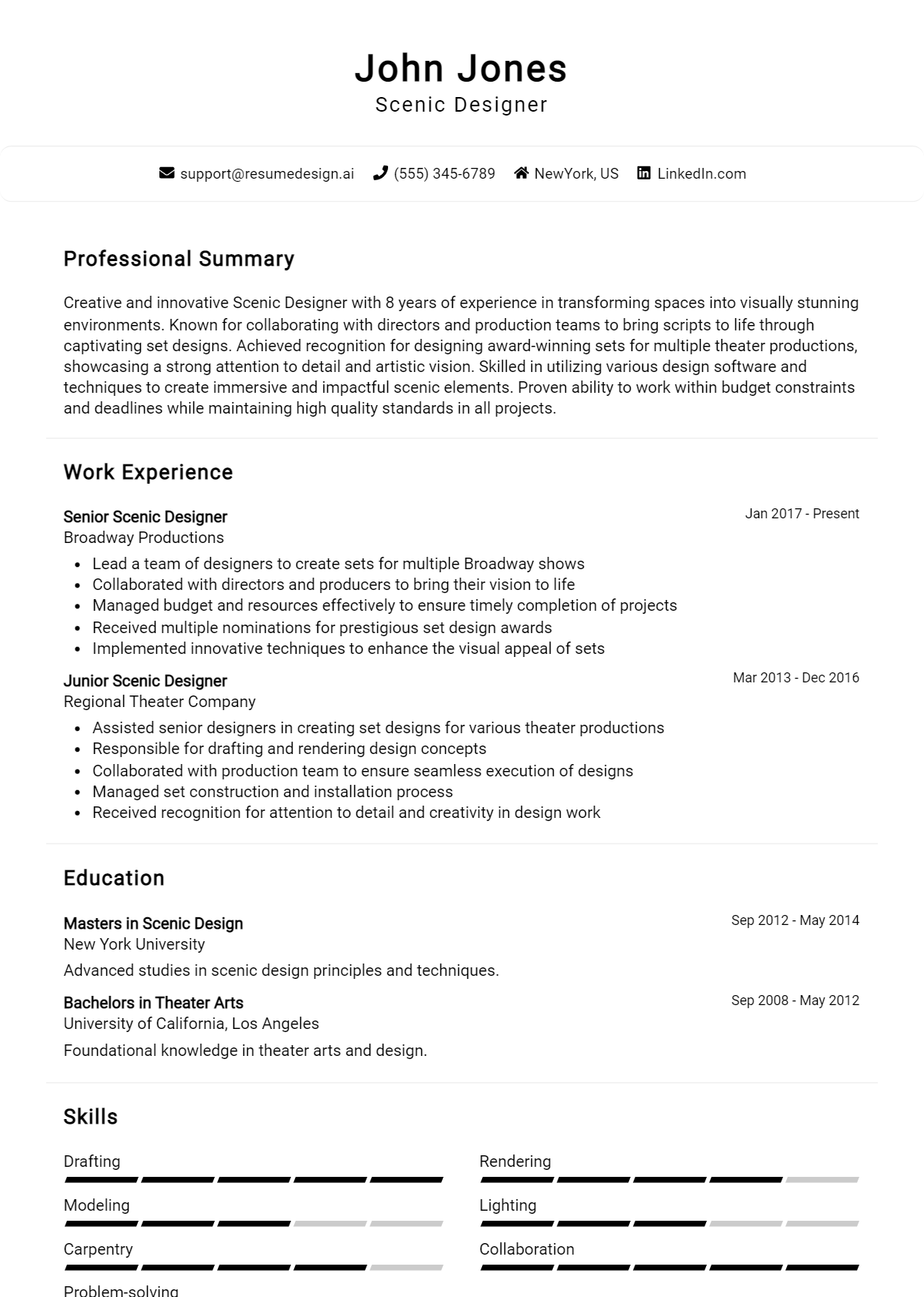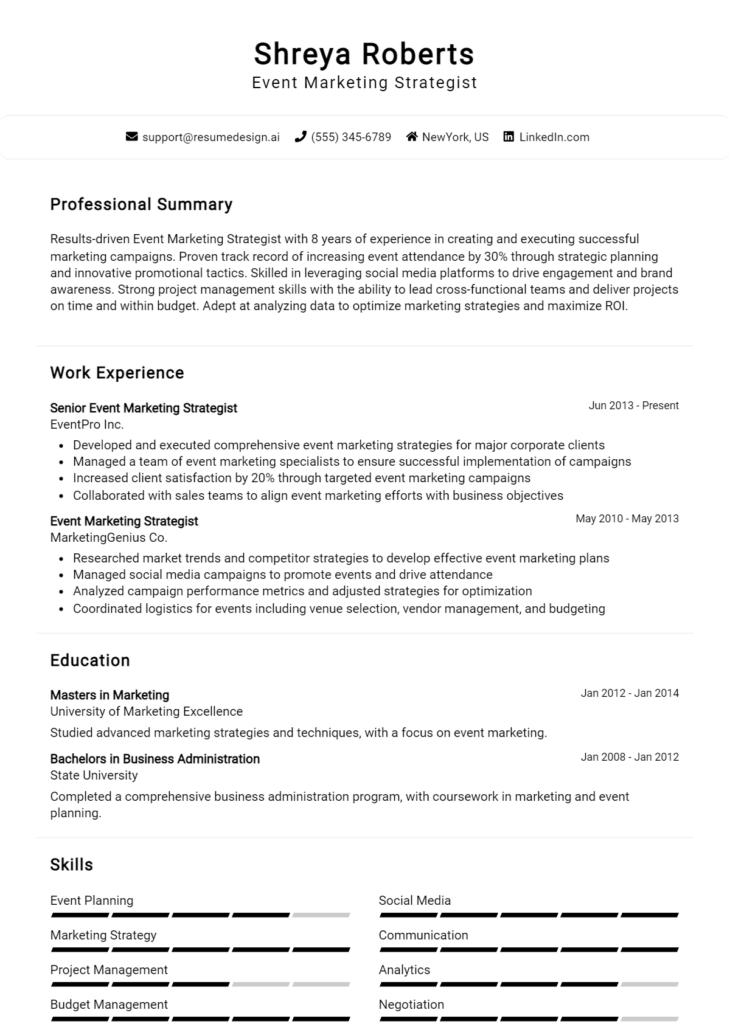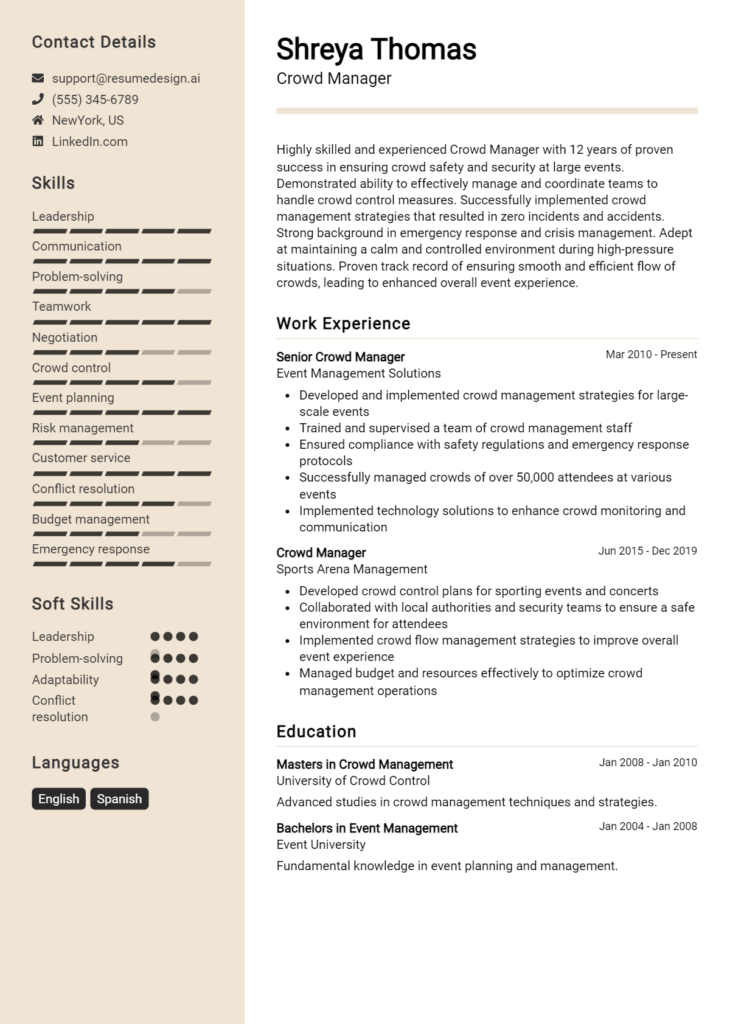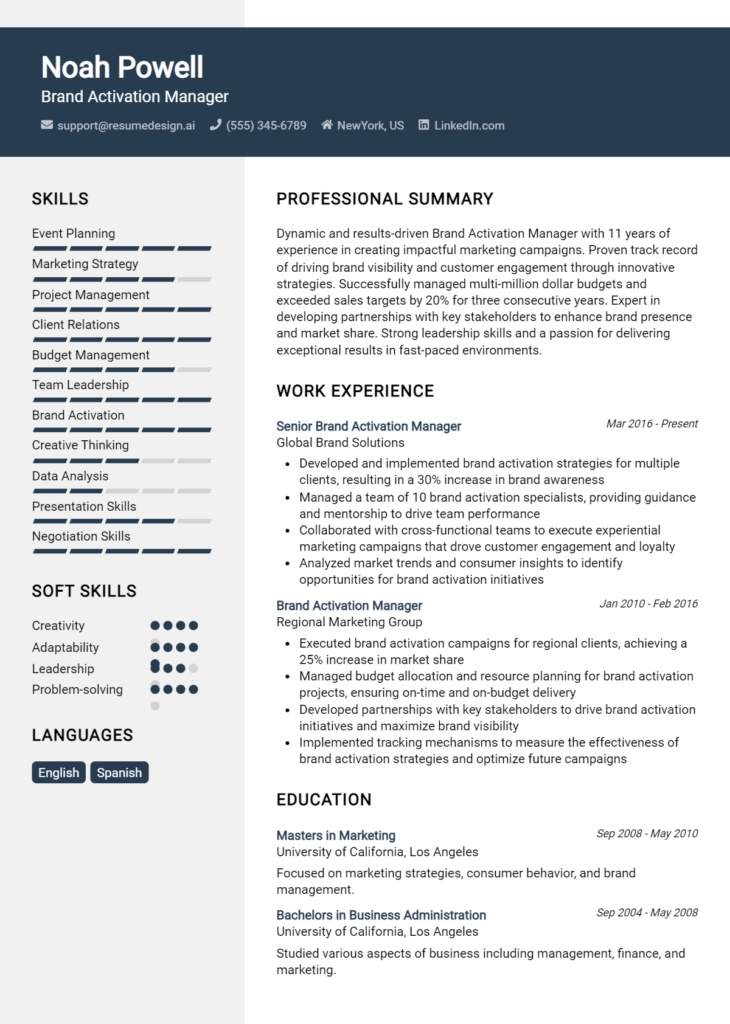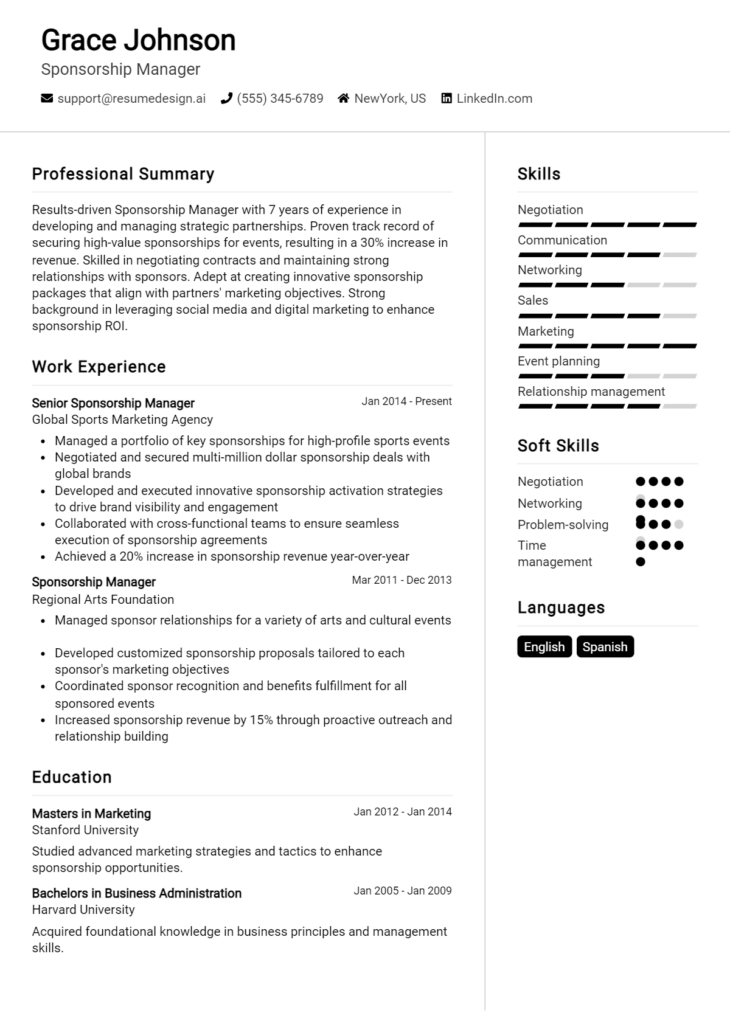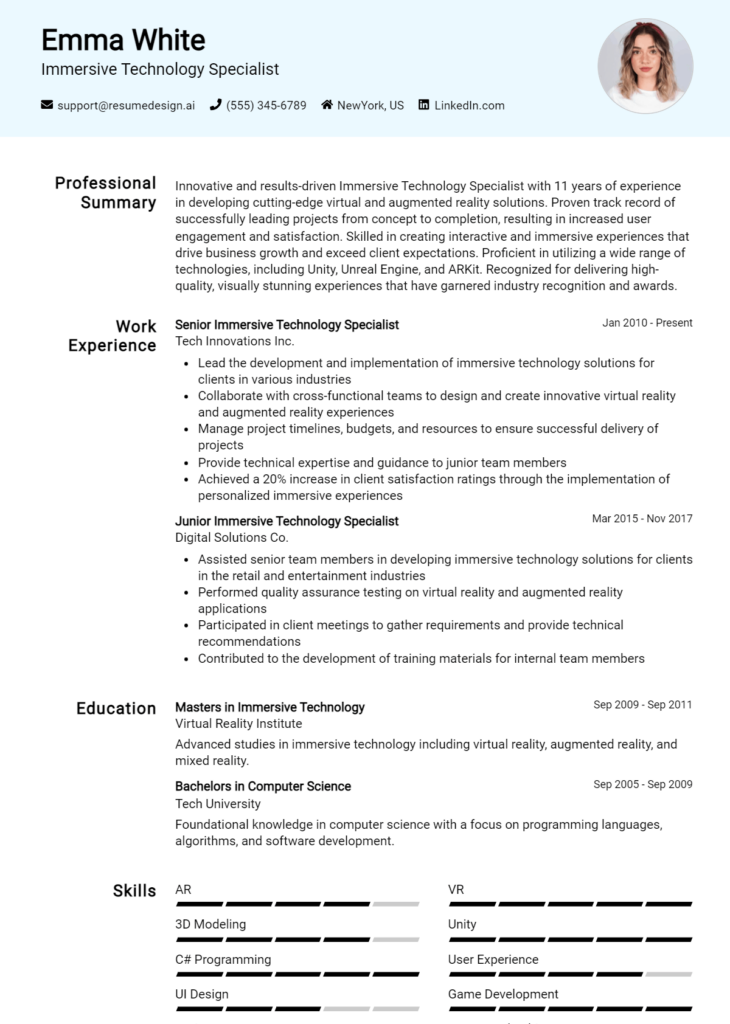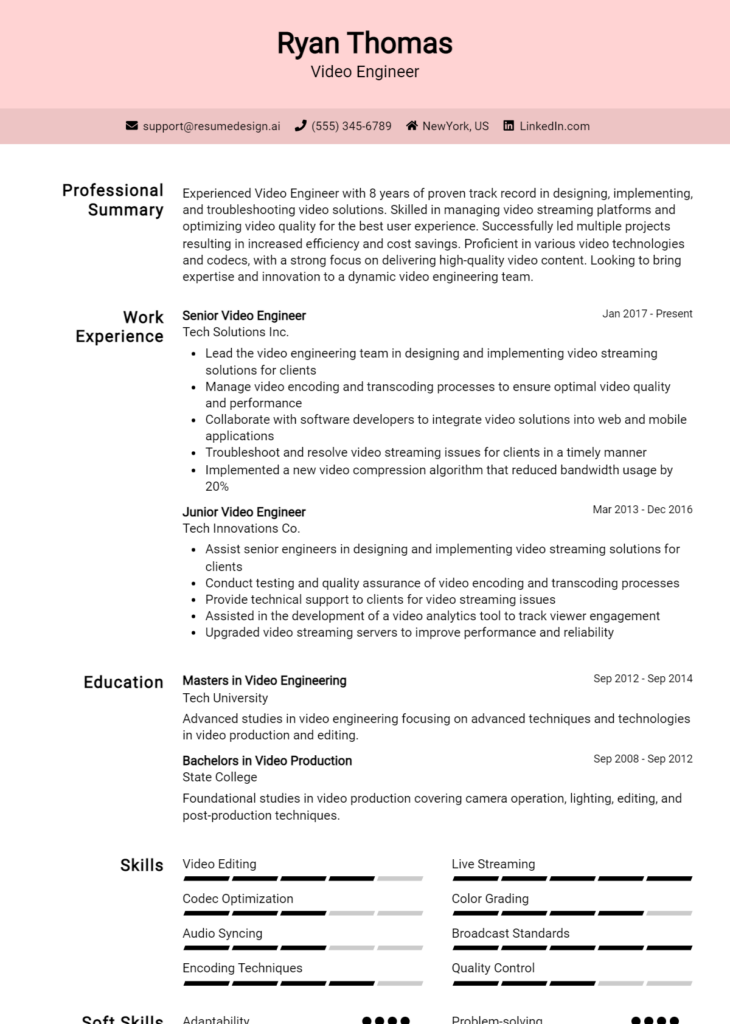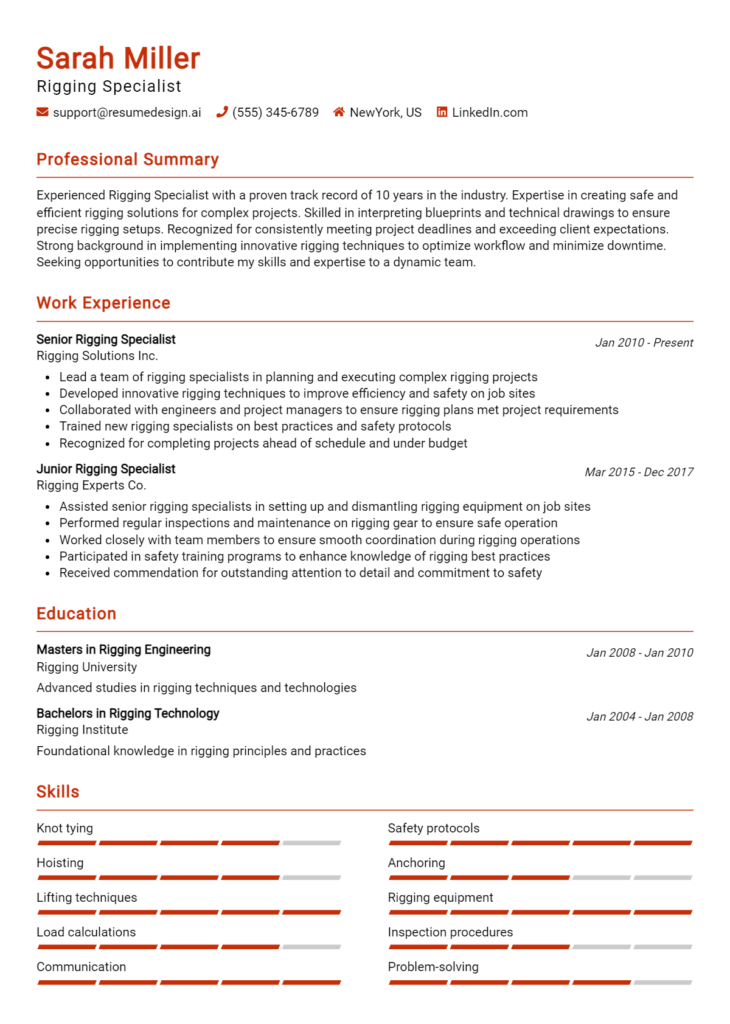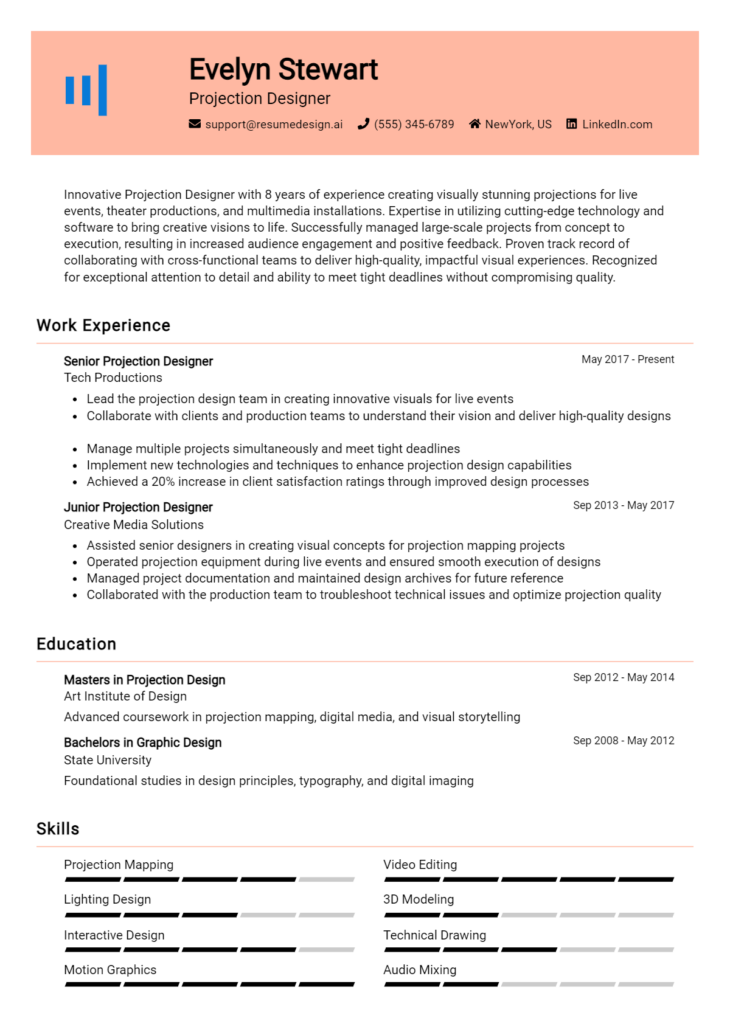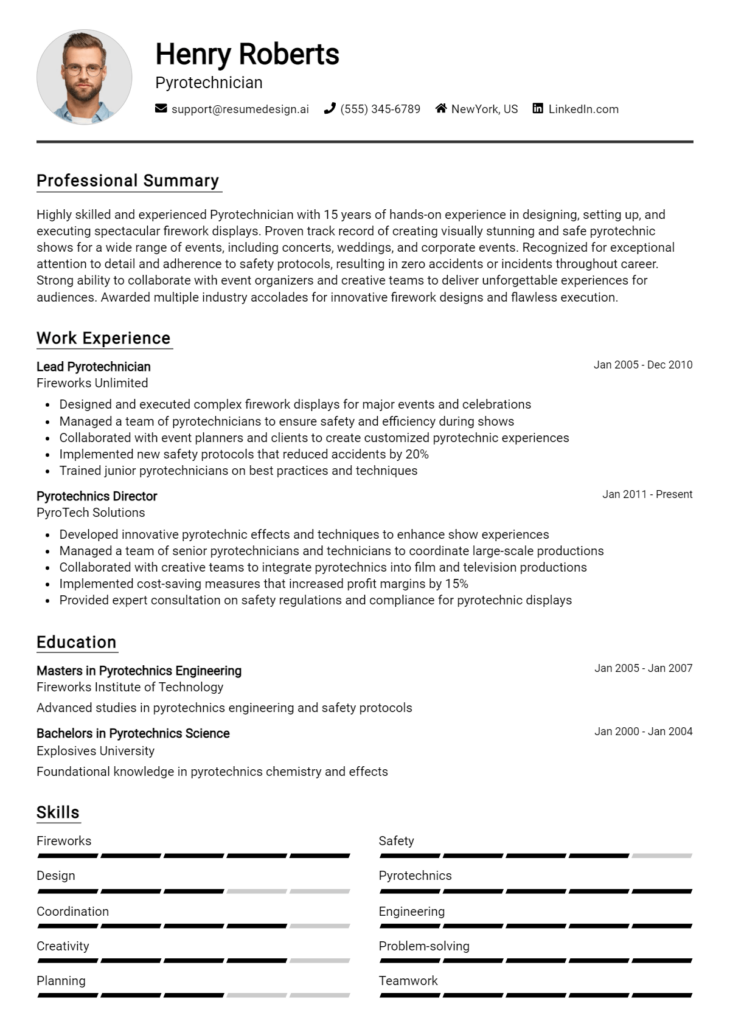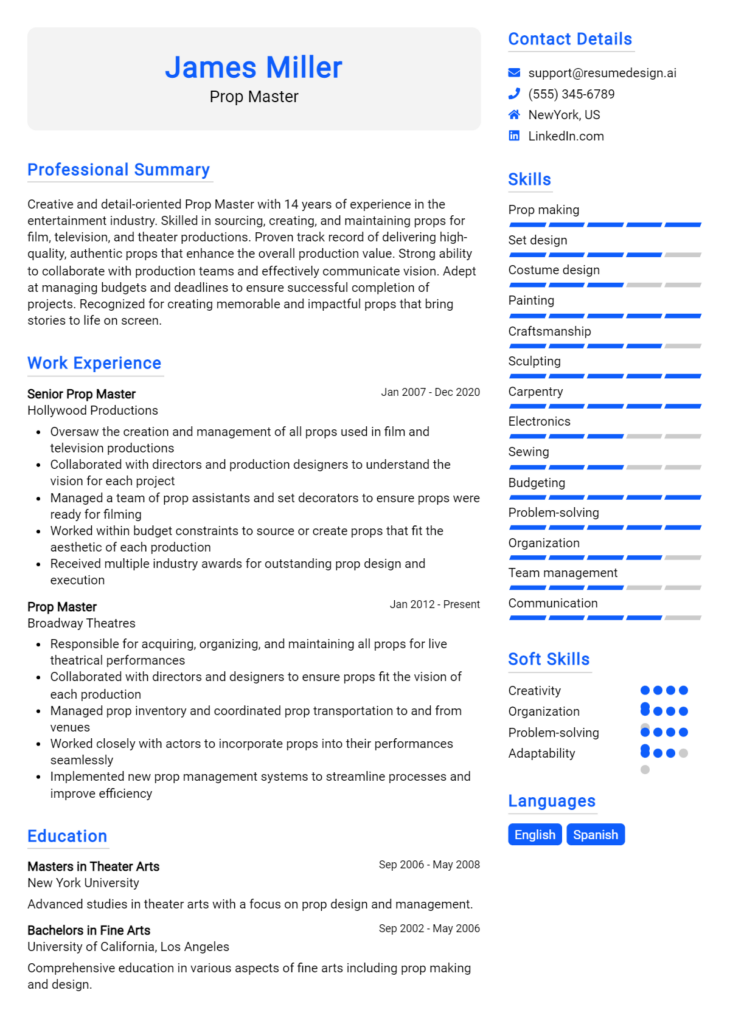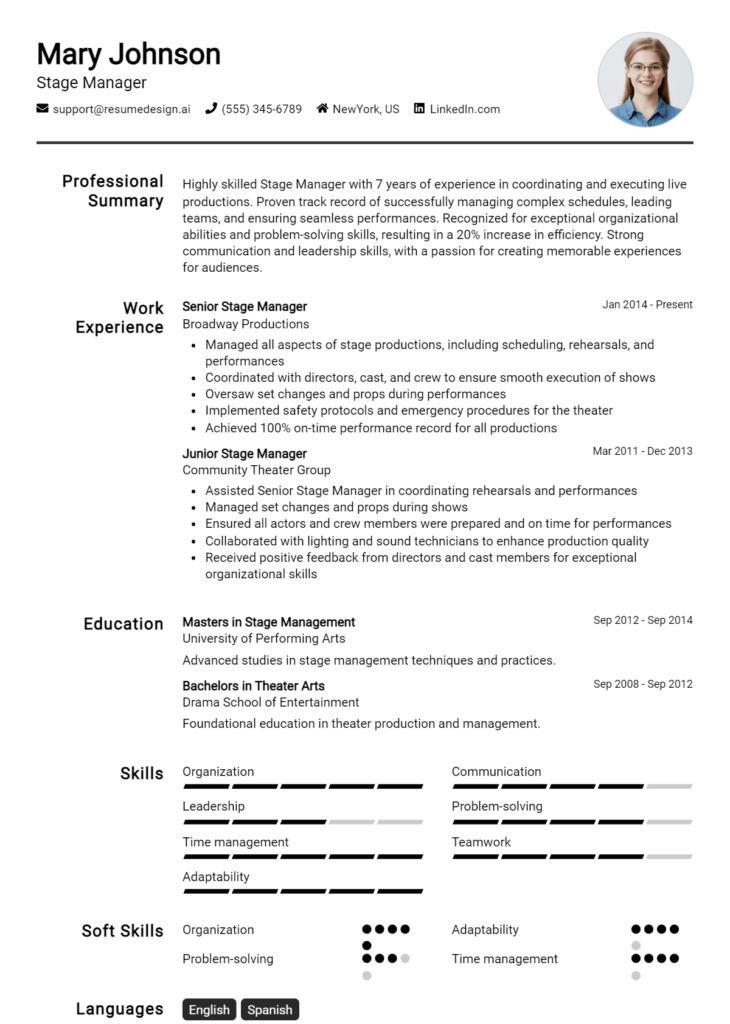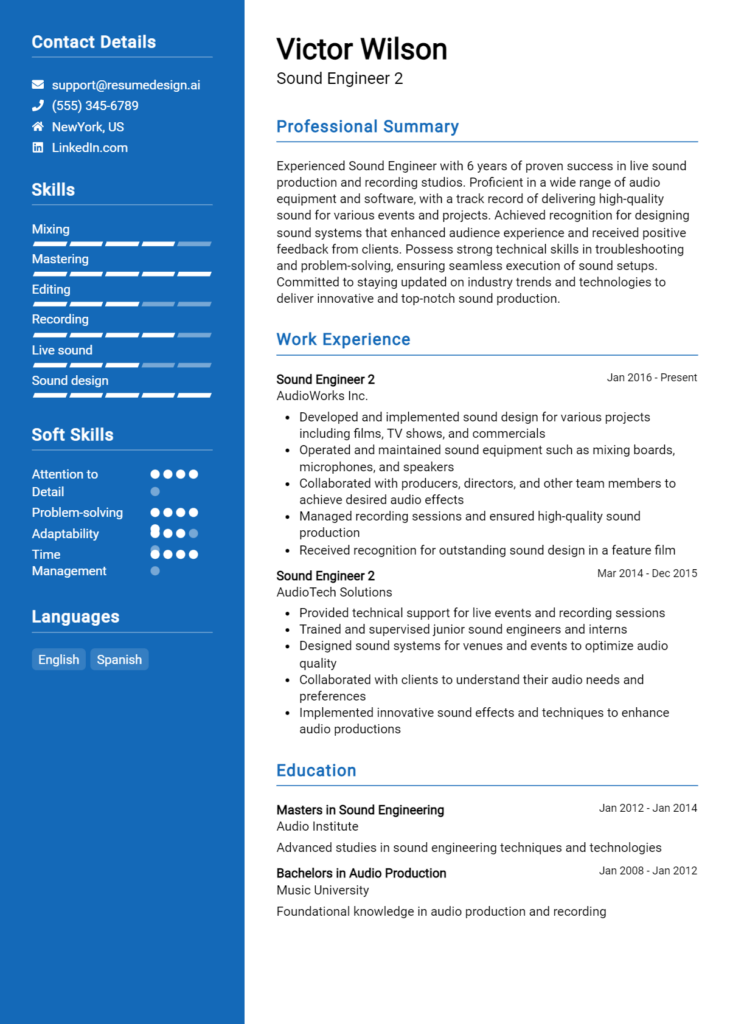Scenic Designer Core Responsibilities
A Scenic Designer is responsible for creating the visual environment of theatrical productions, which requires a blend of creativity and technical expertise. This role bridges various departments, such as lighting, sound, and costume design, ensuring a cohesive vision. Successful Scenic Designers possess strong problem-solving skills, operational knowledge, and an understanding of materials and construction techniques. These competencies are essential for contributing to the organization's artistic goals. A well-structured resume can effectively highlight these qualifications, showcasing the candidate's ability to collaborate and innovate in a dynamic setting.
Common Responsibilities Listed on Scenic Designer Resume
- Develop and present design concepts for theatrical productions.
- Collaborate with directors, producers, and other designers to achieve a unified vision.
- Create detailed scale drawings and models of set designs.
- Select appropriate materials and oversee construction of set pieces.
- Manage budgets and timelines for scenic design projects.
- Conduct on-site inspections to ensure design accuracy and safety.
- Adapt designs based on feedback and production requirements.
- Research historical and contextual elements to inform design choices.
- Coordinate with the lighting and sound departments for integrated design.
- Supervise scene changes and assist during technical rehearsals.
- Maintain organized documentation of design processes and decisions.
High-Level Resume Tips for Scenic Designer Professionals
In the competitive world of scenic design, a well-crafted resume serves as your first opportunity to make a lasting impression on potential employers. It is essential that your resume not only showcases your skills and creativity but also effectively communicates your professional achievements in the field. A compelling resume can highlight your unique artistic vision and technical expertise, setting you apart from other candidates. This guide will provide practical and actionable resume tips specifically tailored for Scenic Designer professionals, ensuring that your application resonates with hiring managers in the theater, film, and event production industries.
Top Resume Tips for Scenic Designer Professionals
- Tailor your resume to the specific job description by incorporating keywords and phrases used in the posting.
- Showcase relevant experience by focusing on past projects that align with the job you are applying for.
- Quantify your achievements where possible, such as the size of the productions you’ve worked on or the budget you managed.
- Highlight industry-specific skills, including proficiency in design software, model-making, and understanding of stagecraft.
- Include a strong portfolio link that demonstrates your past work and creative processes.
- Utilize a clean and professional layout that reflects your artistic sensibilities while ensuring readability.
- Incorporate testimonials or references from directors or producers who can vouch for your talents and work ethic.
- Keep your resume concise, ideally one page, focusing on the most relevant information that showcases your qualifications.
- Use action verbs to describe your responsibilities and achievements to create a dynamic and engaging narrative.
- Stay updated with industry trends and include any recent training or workshops that enhance your skill set.
By implementing these tips, you can significantly increase your chances of landing a job in the Scenic Designer field. A well-structured resume that effectively highlights your skills, accomplishments, and industry knowledge can captivate hiring managers and set the stage for your next career opportunity.
Why Resume Headlines & Titles are Important for Scenic Designer
In the competitive field of scenic design, a well-crafted resume headline or title serves as a critical first impression for hiring managers. It encapsulates key qualifications, skills, and experiences in a succinct phrase that can quickly communicate a candidate's value. A strong headline not only captures attention but also sets the tone for the rest of the resume, making it essential for candidates to ensure their title is both concise and relevant to the job they are applying for. By highlighting their unique strengths in a compelling way, scenic designers can significantly enhance their chances of standing out in a crowded job market.
Best Practices for Crafting Resume Headlines for Scenic Designer
- Keep it concise—aim for one to two impactful phrases.
- Use specific language that directly relates to scenic design.
- Highlight key skills or accomplishments relevant to the job.
- Incorporate industry-specific terminology to demonstrate expertise.
- Focus on your unique selling points, such as awards or notable projects.
- Avoid generic terms; make it personal to your experience.
- Consider using action verbs to convey dynamism and initiative.
- Tailor the headline to each job application for maximum relevance.
Example Resume Headlines for Scenic Designer
Strong Resume Headlines
Innovative Scenic Designer with 10 Years of Experience in Award-Winning Productions
Creative Visionary Specializing in Immersive Environments and Theatrical Spaces
Detail-Oriented Scenic Designer with Proven Track Record in Collaborative Projects
Weak Resume Headlines
Scenic Designer Looking for Work
Experienced Designer
The strong resume headlines effectively convey the candidate's specific skills, years of experience, and unique contributions to the field of scenic design, making them immediately appealing to hiring managers. In contrast, the weak headlines lack detail and specificity, failing to provide any insight into the candidate's qualifications or areas of expertise. This lack of clarity can render them forgettable, underscoring the importance of a compelling and targeted headline in a competitive job market.
Writing an Exceptional Scenic Designer Resume Summary
A well-crafted resume summary is crucial for a Scenic Designer as it serves as the first impression for hiring managers. This brief yet powerful introduction allows candidates to quickly highlight their key skills, relevant experience, and notable accomplishments that align with the specific job role. An impactful summary not only grabs attention but also sets the tone for the rest of the resume, making it essential for candidates to be concise, engaging, and tailored to the job they are applying for.
Best Practices for Writing a Scenic Designer Resume Summary
- Quantify achievements: Use numbers to demonstrate the impact of your work, such as the scale of productions you've worked on or budget management.
- Focus on relevant skills: Highlight specific skills that relate to scenic design, such as 3D modeling, color theory, or collaboration with directors.
- Tailor for the job description: Customize your summary to reflect the keywords and requirements listed in the job posting.
- Keep it concise: Aim for 3-5 sentences that effectively communicate your strengths without being overly verbose.
- Use action verbs: Start sentences with strong action verbs to convey your contributions and achievements dynamically.
- Highlight notable projects: Mention specific productions or designs that exemplify your expertise and creativity.
- Showcase industry knowledge: Include any relevant certifications or knowledge of industry trends that can set you apart.
Example Scenic Designer Resume Summaries
Strong Resume Summaries
Dynamic Scenic Designer with over 8 years of experience in creating immersive environments for theater and film. Successfully managed design projects with budgets exceeding $100,000, resulting in a 20% increase in audience engagement. Proficient in AutoCAD and SketchUp, with a keen eye for detail and a strong background in collaborating with directors and production teams.
Accomplished Scenic Designer known for innovative design solutions that elevate storytelling. Designed sets for over 15 award-winning productions, contributing to a 30% increase in ticket sales. Expertise in sustainable design practices, utilizing recycled materials without compromising artistic vision.
Creative and resourceful Scenic Designer with a proven track record in designing visually stunning sets for both live performances and film. Recognized for transforming concepts into tangible designs, leading to a 95% positive feedback rate from directors and audiences alike.
Weak Resume Summaries
Experienced designer looking for a job in scenic design. I have worked on various projects and have some skills that might be useful.
Passionate about scenic design and eager to contribute to a creative team. I have some experience and am willing to learn.
The strong resume summaries are considered effective because they are specific, quantify achievements, and showcase relevant skills and experience that directly align with the scenic design role. In contrast, the weak summaries lack detail and quantitative outcomes, making them appear generic and unremarkable. They do not effectively communicate the candidate's unique qualifications or the impact of their work, which diminishes their appeal to hiring managers.
Work Experience Section for Scenic Designer Resume
The work experience section of a Scenic Designer resume is crucial as it serves as a testament to the candidate's practical application of their skills and knowledge in real-world settings. This section not only highlights the technical expertise that the designer possesses—such as proficiency in software like AutoCAD or SketchUp—but also underscores their ability to lead teams and manage complex projects that result in high-quality productions. By quantifying achievements and aligning their experiences with industry standards, candidates can effectively demonstrate their value and readiness for the challenges of scenic design.
Best Practices for Scenic Designer Work Experience
- Detail specific technical skills used in each project, such as CAD software, model-making, or painting techniques.
- Quantify achievements with metrics, such as budget savings, time management improvements, or audience engagement statistics.
- Highlight collaborative efforts, emphasizing teamwork with directors, lighting designers, and other departments.
- Use action verbs to convey impact, such as "designed," "led," "collaborated," or "implemented."
- Focus on relevant experiences that align with the job description and industry standards.
- Include awards or recognitions received for specific projects to bolster credibility.
- Provide context for each experience, explaining the production type and scale to give a clearer picture of the work done.
- Tailor the descriptions to reflect the unique demands of each role while maintaining a consistent professional tone.
Example Work Experiences for Scenic Designer
Strong Experiences
- Designed and executed scenic elements for a major regional theater's production of "Hamlet," resulting in a 30% increase in ticket sales compared to previous performances.
- Led a team of 5 in the creation of a large-scale outdoor installation for a summer festival, completing the project 2 weeks ahead of schedule while staying 15% under budget.
- Collaborated closely with lighting and costume designers on a musical that received a local award for Best Production Design, praised for its cohesive visual storytelling.
Weak Experiences
- Helped with the set design for a show.
- Worked on various projects with different teams.
- Participated in the design process for a theater production.
The examples provided illustrate a clear distinction between strong and weak experiences. Strong experiences specify quantifiable outcomes and demonstrate effective leadership and collaboration, showcasing the candidate's contributions to successful projects. In contrast, weak experiences lack detail and specificity, failing to convey the candidate's skills or impact meaningfully. By focusing on measurable results and detailed roles in projects, candidates can create a compelling narrative of their professional journey in scenic design.
Education and Certifications Section for Scenic Designer Resume
The education and certifications section of a Scenic Designer resume is critical in establishing a candidate's qualifications and expertise within the theatrical and design industries. This section not only showcases the candidate's academic background but also emphasizes their commitment to professional development through industry-relevant certifications and continuous learning efforts. By providing details about relevant coursework, specialized training, and recognized certifications, candidates can significantly enhance their credibility and demonstrate their alignment with the specific requirements of the job role. This information can set them apart in a competitive job market, showcasing their preparedness to succeed in the intricacies of scenic design.
Best Practices for Scenic Designer Education and Certifications
- Include degrees in theater, fine arts, design, or related fields to demonstrate foundational knowledge.
- List industry-recognized certifications, such as those from the United States Institute for Theatre Technology (USITT) or similar organizations.
- Highlight relevant coursework that aligns with scenic design, such as stagecraft, lighting design, and set construction.
- Provide details about any specialized training workshops or seminars attended that focus on contemporary design techniques.
- Use clear and concise language to describe each qualification, ensuring it is easy for employers to read.
- Emphasize ongoing education efforts, such as online courses or certifications that reflect current trends in scenic design.
- Organize the section in reverse chronological order, starting with the most recent education and certifications.
- Consider including notable projects or collaborations related to educational experiences that demonstrate practical application of skills.
Example Education and Certifications for Scenic Designer
Strong Examples
- BFA in Scenic Design, University of the Arts, Philadelphia, PA
- Certificate in Theatre Production, Yale School of Drama
- Completed coursework in Lighting Design and Stagecraft at the California Institute of the Arts
- Member of the United States Institute for Theatre Technology (USITT) since 2020
Weak Examples
- High School Diploma, Springfield High School, Springfield, IL
- Certification in Graphic Design, Community College of Springfield
- Completed a workshop on Basic Drawing Techniques in 2015
- Old certification in Floral Design from 2008
The strong examples are considered effective because they directly relate to the field of scenic design, showcasing relevant degrees and certifications that highlight the candidate's expertise and commitment to the profession. In contrast, the weak examples demonstrate a lack of focus on the specific skills and knowledge required for scenic design. They feature outdated or unrelated qualifications that do not enhance the candidate's profile in the context of a scenic designer's role, thereby diminishing their credibility in a competitive job market.
Top Skills & Keywords for Scenic Designer Resume
A well-crafted resume is essential for a Scenic Designer, as it showcases not only your artistic vision but also the technical expertise and interpersonal skills necessary for the role. Highlighting your skills effectively can set you apart from other candidates, demonstrating your ability to bring a creative concept to life while collaborating with directors, actors, and other production team members. By emphasizing both hard and soft skills, you can present a well-rounded profile that appeals to hiring managers looking for versatile talent in the competitive field of scenic design.
Top Hard & Soft Skills for Scenic Designer
Soft Skills
- Creativity
- Collaboration
- Communication
- Problem-solving
- Time management
- Attention to detail
- Flexibility
- Adaptability
- Critical thinking
- Emotional intelligence
- Visionary thinking
- Negotiation skills
- Conflict resolution
Hard Skills
- Drafting and technical drawing
- 3D modeling software proficiency (e.g., SketchUp, AutoCAD)
- Knowledge of color theory
- Scenic painting techniques
- Model making
- Set construction and materials knowledge
- Lighting design fundamentals
- Prop design and fabrication
- Knowledge of theatrical rigging
- Familiarity with historical design styles
- Budgeting and cost estimation
- Stage management
- Computer-aided design (CAD)
These skills are vital for a Scenic Designer, ensuring that you not only meet the creative demands of the job but also navigate the practical challenges of production. Furthermore, having a strong work experience section that complements these skills will enhance your resume and improve your chances of landing interviews.
Stand Out with a Winning Scenic Designer Cover Letter
Dear [Hiring Manager's Name],
I am excited to submit my application for the Scenic Designer position at [Company/Production Name]. With a Bachelor’s degree in Fine Arts and over five years of hands-on experience designing immersive theatrical environments, I possess a unique blend of creativity and technical skill that I believe aligns perfectly with the needs of your team. My work has been recognized for its innovative use of space and materials, and I am eager to bring this passion and expertise to your upcoming projects.
Throughout my career, I have collaborated closely with directors, lighting designers, and production teams to create cohesive and visually stunning sets. One of my recent projects involved designing a complex, multi-layered set for a contemporary adaptation of a classic play, which required not only artistic vision but also a deep understanding of the practicalities of stagecraft. My ability to conceptualize designs through sketches and 3D models has allowed me to effectively communicate my ideas, ensuring that every production runs smoothly from concept to execution. Additionally, my proficiency in software such as AutoCAD and SketchUp enables me to create precise technical drawings that facilitate seamless collaboration with fellow designers and builders.
I am particularly drawn to [Company/Production Name] because of your commitment to innovative storytelling and high-quality productions. I admire your recent work on [specific production or project], which showcased a remarkable level of creativity and attention to detail. I am eager to contribute to your team by bringing my fresh perspective and dedication to creating captivating scenic designs that enhance the overall narrative of each production. I believe that a well-designed set not only serves as a backdrop but also plays a crucial role in shaping the audience's experience.
Thank you for considering my application. I look forward to the opportunity to discuss how my skills and experiences align with the goals of [Company/Production Name]. I am excited about the possibility of contributing to your team and helping to create extraordinary theatrical experiences.
Sincerely,
[Your Name]
[Your Contact Information]
[Your LinkedIn Profile or Portfolio Link]
Common Mistakes to Avoid in a Scenic Designer Resume
When crafting a resume for a scenic designer position, it's essential to present your skills and experiences in a way that highlights your creativity and technical abilities. However, many applicants make common mistakes that can detract from their overall presentation and impact. Avoiding these pitfalls can significantly enhance your chances of landing an interview. Here are some common mistakes to watch out for:
Lack of Specificity: Failing to provide detailed descriptions of past projects can make it difficult for hiring managers to understand your experience. Always include specifics about the types of productions you’ve worked on, your role, and the techniques you employed.
Ignoring Keywords: Scenic design is a field with specific terminology. Neglecting to include relevant keywords from the job description can result in your resume being overlooked by applicant tracking systems.
Overly Generic Language: Using vague phrases like “responsible for design” doesn’t showcase your unique contributions. Instead, use action verbs and specific examples to convey your impact on each project.
Cluttered Layout: A resume that is difficult to read or overly busy can frustrate hiring managers. Aim for a clean, organized layout with clear headings and sufficient white space to enhance readability.
Neglecting Visual Elements: As a scenic designer, your visual skills are crucial. Including a link to your portfolio or attaching relevant images can help demonstrate your design capabilities effectively.
Omitting Relevant Skills: Failing to highlight specific skills such as CAD proficiency, model making, or collaboration with directors can make your resume less compelling. Make sure to tailor your skills section to the requirements of the job.
Not Tailoring for Each Application: Sending out a one-size-fits-all resume can be detrimental. Customize your resume for each position by emphasizing the most relevant experiences and skills that align with the job description.
Forgetting to Proofread: Spelling and grammatical errors can undermine your professionalism. Always proofread your resume or ask someone else to review it before submission to catch any mistakes.
Conclusion
As a Scenic Designer, your role is pivotal in creating the visual landscape that brings a production to life. Throughout this article, we explored the essential skills required for a successful career in scenic design, such as conceptualization, collaboration with directors and other design teams, and proficiency in various design software. We also highlighted the significance of a strong portfolio that showcases your creativity and technical abilities.
Moreover, we discussed the importance of understanding the narrative and thematic elements of a production, as well as the ability to work within budget constraints while delivering high-quality designs. Networking within the industry and staying updated with current design trends are also critical aspects that can enhance your career trajectory.
Now that you have a clearer understanding of what it takes to excel as a Scenic Designer, it's time to reflect on your own qualifications and experiences. Is your resume effectively showcasing your talents and achievements? Take action today by reviewing your Scenic Designer Resume to ensure it captures your unique skills and experiences.
To assist you in this process, consider utilizing available resources such as resume templates, a user-friendly resume builder, curated resume examples, and tailored cover letter templates. These tools can help you create a polished and professional presentation that stands out to potential employers. Don't miss the opportunity to elevate your career as a Scenic Designer!

